A Step-by-Step Guide to Cast Android to Windows 10 with Ease
Learn how to cast Android to Windows 10 with ease! Follow our Step-by-step guide to discover various methods for an effortless screen mirroring experience.
A Step-by-Step Guide to Cast Android to Windows 10 with Ease
- Fast response time within 10 ms and 60fps frame rate.
- A stunning visual experience with no color difference.
- Lag-free screen mirroring and 4k resolution.
- Works well on both Windows and macOS.
Available for both Win & Mac
Are you tired of straining your eyes to view content on your Android phone? Do you want a bigger and better viewing experience? If yes, then we got you covered!
Screen casting solves your problems and is useful in many ways. Whether you want to share media with a group of people or to play games on a big screen, it can serve the purpose. You can also access different apps and check notifications directly on your PC.
In this article, we will walk through different methods to cast Android to Windows 10. But before heading to the steps, let’s talk about screencasting!
Table of ContentsHide
Screen Casting vs. Screen Mirroring vs. Screen Sharing
People often confuse screen casting, screen mirroring, and screen sharing. However, these terms differ in how they display content to other devices.
Let’s understand!
- Screen Casting: Screen casting is showing videos or photos from one device to another. The content is sent to the other device and can be shown without needing the original device. For example, you can play a YouTube video from your smartphone on your smart TV without needing your phone later.
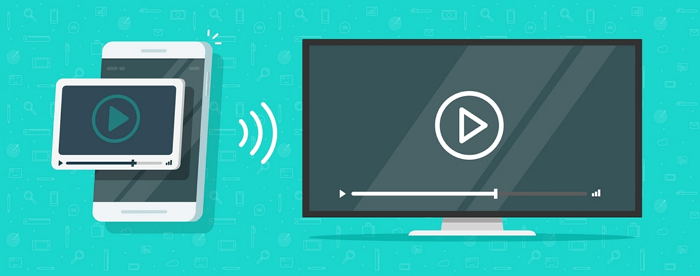
What is Screen Casting
- Screen Mirroring: Screen mirroring mirrors the entire display of one device onto another. Everything you see on the source device will be shown on the receiving device’s screen in real-time. For example, if you mirror your smartphone’s screen to your pc, you will see an exact copy of your phone’s interface on your PC.
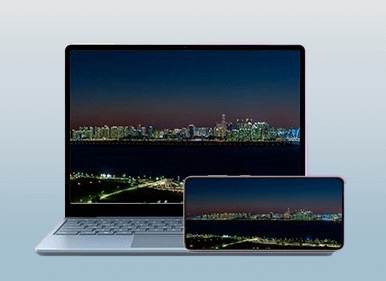
What is Screen Mirroring
- Screen Sharing: Screen sharing allows someone else to view or control your screen remotely. When you share your screen, the other person can see what’s on your display and may even be able to interact with it. For example, you can share your screen during an online meeting to discuss a document with other participants.

What is Screen Sharing
However, in this article, “cast Android to PC” means displaying your Android phone screen on a PC. This process is also called screen mirroring. It lets you share media, access apps, and play games on a big screen.
Let’s dive into the methods now!
How to Cast Android to Windows 10/11?
Users can cast Android to Windows 10/11 with the help of a Wireless Display, also known as WiFi Display or Miracast. It is an integrated feature of Windows 10 and 11 operating systems.
This built-in feature was introduced in Windows 8.1. Since then, it has become a widely used tool for screen mirroring and content sharing between devices.
The best part is there’s no need for any cables or software. You can directly use this feature in Windows 10/11. But before using it, you need to set up Wireless Display on your PC.
1. Steps to Setup Wireless Display
You can follow the instructions given below to setup the Wireless Display:
Step 1. Right-click the Windows Start button, then open Device Manager > Network Adapters. If you see Intel ® Dual Band Wireless-AC 3160, or something similar, your device supports Wireless Display.

Check Wireless Display Supported File on PC
Step 2. Turn on the Wi-Fi and Bluetooth on your Windows computer.
Step 3. Open the Windows Settings > System > Projecting to this PC. Scroll down and enable the toggle as displayed in the below picture.
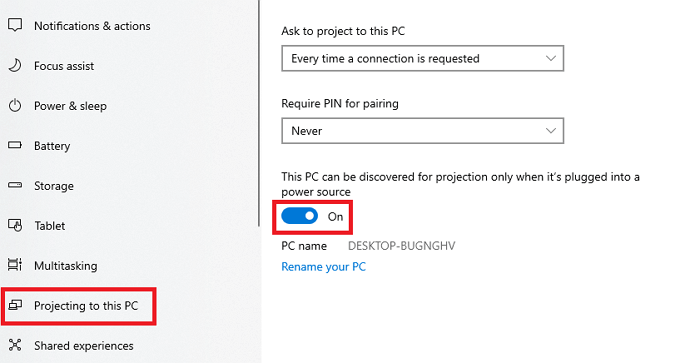
Enable Projecting on This PC
Once the toggle is enabled, your Wireless Display is all set to connect to an Android device.
2. Steps to Cast Android to Windows 10/11
You can follow the instructions given below to cast Android to PC:
Step 1. Turn on the WiFi and Bluetooth on your Android device and pair it with your PC or laptop.
Step 2. In the Projecting to this PC menu, click Launch the Connect app to project to this PC. Once clicked, you will see the below interface.
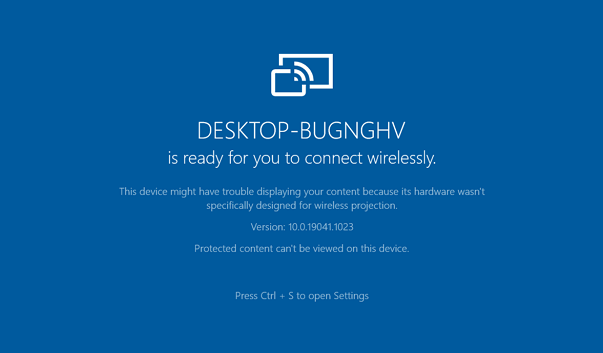
Wireless Display is Ready for Your Computer
Step 3. Now open the quick settings menu and enable the Smart View or Cast Screen option. Select your PC and your phone screen will be displayed on your PC.
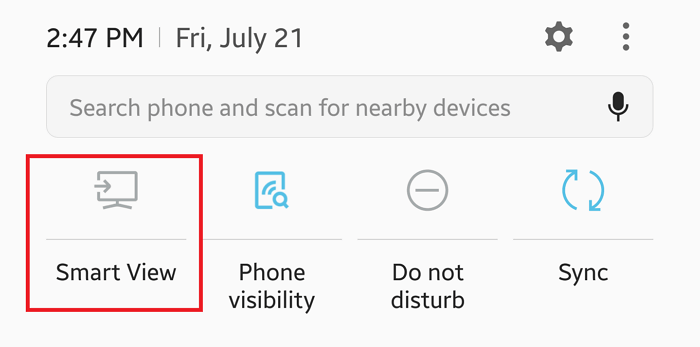
Use Android Built-in Feature to Screen Mirror
Remember, not all Windows computers support the Wireless Display feature. However, if your PC is not compatible, the next method is for you. Don’t miss it!
Cast Android Screen to Windows 10/11 Without Limits
You may encounter issues while trying to cast Android to PC using the Windows Wireless Display feature. In this case, a third-party app like AnyMiro is a blessing in disguise. It allows you to cast Android to Windows 10/11 without any limitations.
Additionally, using a third-party app like AnyMiro also comes with several advantages. It offers a smooth mirroring experience with high-quality audio/visuals. The good part is you don’t need to be a tech bee to use AnyMiro.
Let’s shed some light on how to mirror Android to PC.
How to Cast Android to Windows with AnyMiro
Here’s how you can cast Android to Windows 10/11 with AnyMiro:
*With this method you need to download both the AnyMiro software and the mobile app.
Step 1. Download and install AnyMiro software on your computer.
Free Download for all windows & 100% safe Free Download for all mac & 100% safe
Free Download100% Clean & Safe
Step 2. Launch the app and select Android as your mobile type.
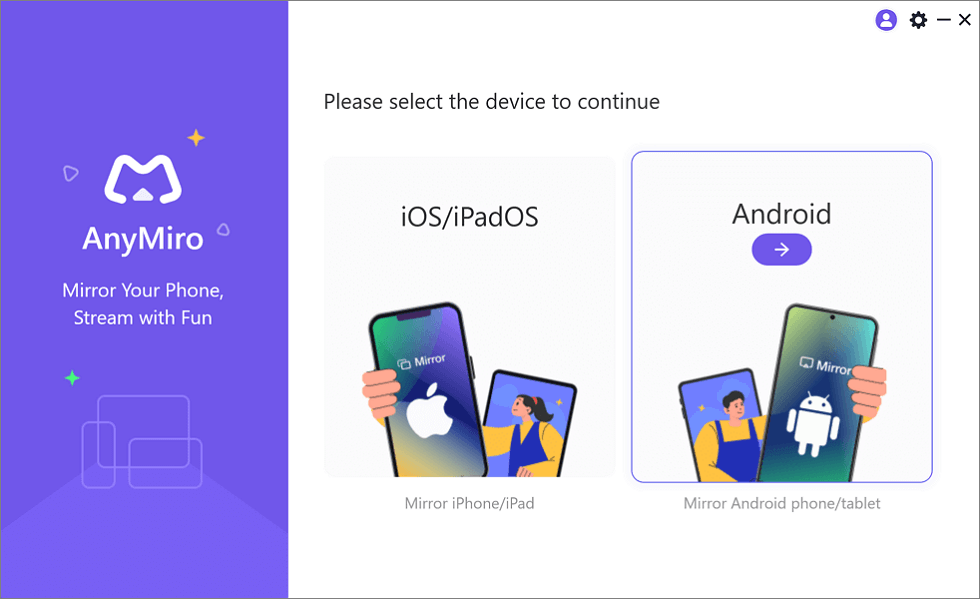
Mirror Android to Computer
Step 3. Select USB as a connection mode and connect your Android phone to your computer via a USB cable. (You can also select WiFi if you have a stable connection)

Mirror iOS Device to Computer via USB
Step 4. Then, enable USB debugging and choose the MTP mode.
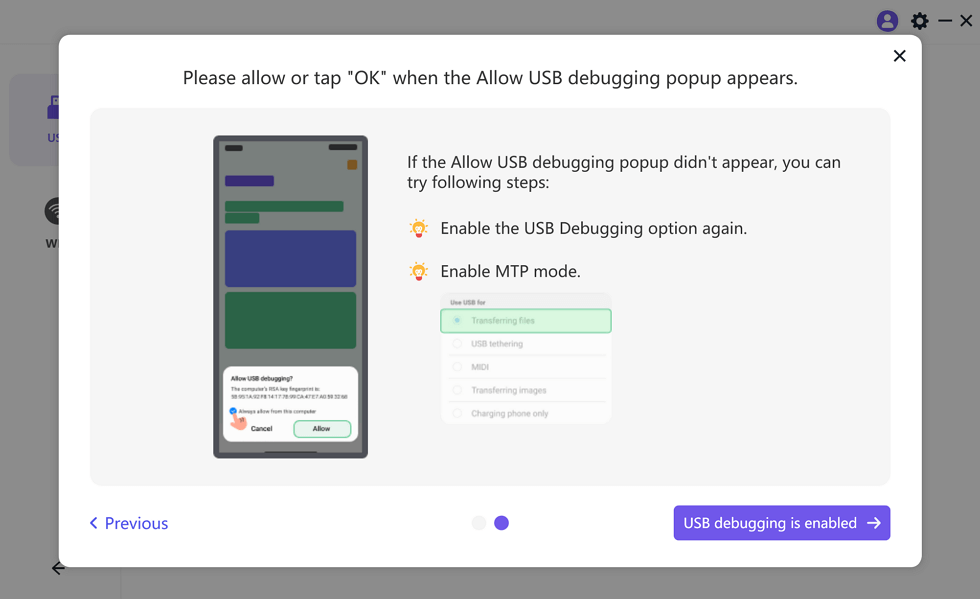
Enable USB Debugging and MTP Mode for a USB Connection
Step 5. Then open the AnyMiro app on your phone, tap Start in USB connection, and wait a few seconds, you can see your Android screen on your PC.
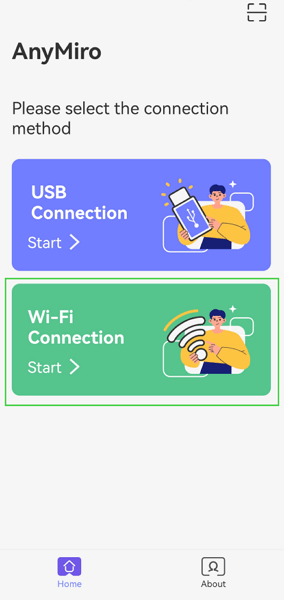
Select the Connection Method
Let’s explore more features of AnyMiro that make it the best among other mirroring apps.
More Features of AnyMiro
Here are a few features that make AnyMiro the best choice:
- Support Mirroring iPhone to Windows: There are no limitations on the type of devices. AnyMiro supports both to mirror screens to a PC whether you have an Android or iPhone.
- No Latency and More Stable: The best thing is, AnyMiro offers a lag-free and stable screen mirroring experience. This means you can enjoy your gameplay and live streams without any interruptions.
- Stunning Visual Experience with No Color Difference: AnyMiro offers amazing color accuracy to ensure your display is clear and detailed when mirrored to your computer. It shows the best resolution, up to 4K, like your original screen.
- Fast Response Time: It provides a fast response time within 10ms, 120Hz refresh rate, and 60fps frame rate. This format makes the screen mirroring experience even more swift and smooth.
These amazing features surely got you excited, and now you might be wondering which connectivity option to go for. Well, don’t worry! We have the answer for you.
USB vs WiFi – Which is The Best Android Casting Method?
The USB screen mirroring allows you to view phone screen on PC via USB. It is stable and secure but requires a wired connection. On the other hand, WiFi screen mirroring is wireless and offers more mobility, but it relies on a stable WiFi network. Also, there might be security risks. However, you can go through the pros and cons of both connectivity options and select one that you think will work for you.
USB
The pros & cons of using a USB cable as the Android casting method are as follows:
| Pros | Cons |
| Minimal lag and smoother performance. | A USB cable can restrict mobility. |
| Secure, as it allows access to authorized devices only. | / |
| No need for an internet connection. | / |
WiFi
The pros & cons of using WiFi as the Android casting method are as follows:
| Pros | Cons |
| Offers flexibility and mobility during casting. | Require a stable WiFi network. |
| No need for a USB cable. | Might have security risks. |
| Offers a larger range of distance. | Mirroring quality can vary according to the WiFi. |
FAQs About Cast Android to Windows
Q. How to Cast Android to PC via Bluetooth?
You can only Cast Android to PC via Bluetooth if the host device has the Miracast feature. Bluetooth alone cannot cast Android to Windows 10/11. However, if your PC doesn’t have the built-in feature, you can try AnyMiro.
Q. Can Windows 10 do screen mirroring?
Yes, it can! If you use Windows 10 and the host device supports Wireless Display, you can cast Android to PC with the default Connect Application. You can also try AnyMiro for this purpose. It works fine on both Android and Windows.
Q. Is it possible to mirror Android to PC?
Yes, it is! You can use Windows’ default feature (Wireless Display) or a third-party screen mirroring app, like AnyMiro, to cast Android to PC. It’s user-friendly and supports all Android/iOS devices and Win/Mac operating systems.
Q. Does YouTube support screen mirroring?
Yes, YouTube does support screen mirroring from Android to PC or TV. The best thing is you don’t need any third-party tools. Just play any video on YouTube, click the screen casting icon, and connect it to your device. Once it is connected, you will see the video playing on your PC or TV.
The Bottom Line
Hopefully, this article has helped you learn various ways to cast Android to PC. The above methods let you watch your phone’s content on a bigger screen in a few simple steps.
However, for a user-friendly and reliable way to cast Android to Windows 10/11, we recommend trying AnyMiro. Whether you choose a wired or wireless method, AnyMiro enables seamless screen mirroring.
So, download AnyMiro today and take your screen mirroring to the next level. Because AnyMiro lets you experience seamless connectivity and take control of your digital world today!
AnyMiro – Real-Time Screen Mirroring Tool
Free download AnyMiro to enjoy a fast, stable, and smooth screen mirroring experience. You can mirror for better game playing, video watching, or live streaming mobile phone content.
More Related Articles
Product-related questions? Contact Our Support Team to Get Quick Solution >

